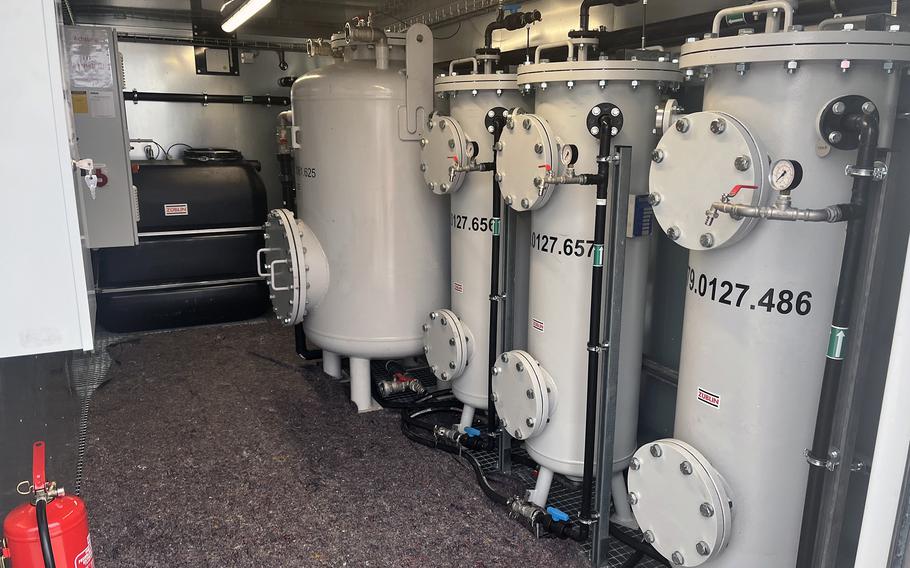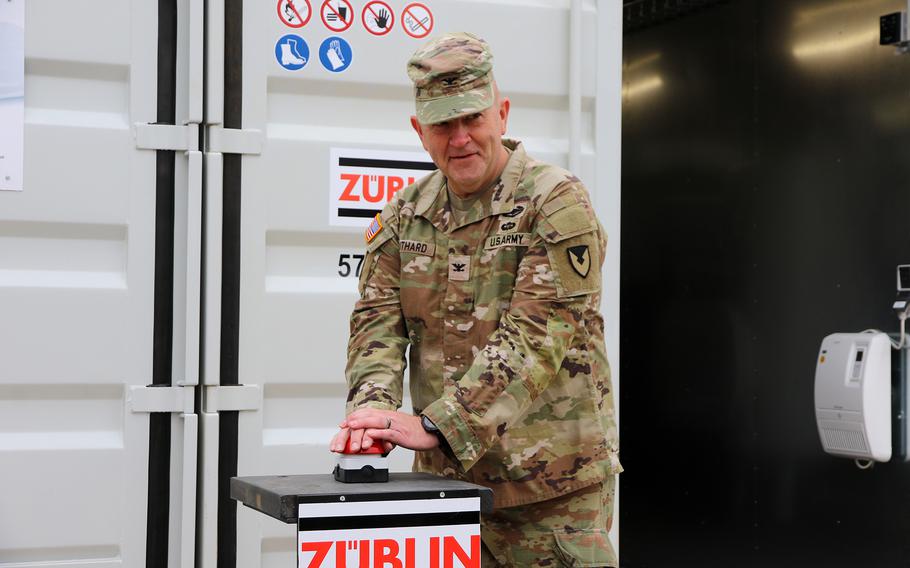
A new hydraulic containment system that will filter PFAS chemicals from the groundwater is now operating at U.S. Army Garrison Ansbach, Germany, on Oct. 15, 2024. (Matthew M. Burke/Stars and Stripes)
ANSBACH, Germany — German engineers switched on a water treatment system at U.S. Army Garrison Ansbach this week to begin the long-planned purge of toxic PFAS chemicals from groundwater exiting the base.
Construction of the hydraulic containment system began April 10 alongside the base’s western fence line by Züblin, a Stuttgart-based construction and civil engineering firm, 10 years after the “forever chemicals” were discovered.
The purification unit is expected to pump and treat over 35,000 gallons per day from underneath a former firefighter training site near Katterbach Airfield before they are released into the base’s stormwater channels, garrison commander Col. Aaron Southard said Tuesday during an opening ceremony where he pushed a symbolic red button.
“This facility represents more than just a solution to a problem; it is a symbol of our shared dedication to safeguarding public health and preserving our natural resources for future generations,” Southard said.
Southard was joined at the ceremony by Ansbach Lord Mayor Thomas Deffner.

Col. Aaron Southard, commander of U.S. Army Garrison Ansbach, pushes a ceremonial red button on Oct. 15, 2024, in Ansbach, Germany, signifying the start of a new hydraulic containment system that will filter toxic PFAS chemicals from the groundwater exiting the base. (Matthew M. Burke/Stars and Stripes)
PFAS, or manmade per-and polyfluoroalkyl substances, are used to make coatings and products that resist heat, oil, stains, grease and water, according to the Centers for Disease Control and Prevention. They’re also found in firefighting foam historically used at U.S. military bases around the world. PFOS and PFOA are two common types.
PFAS compounds accumulate in the body over time and have been linked to a slew of adverse health conditions from increased cholesterol to liver and immune system damage, low birth weight and certain cancers, the CDC website said.
Both the U.S. and Germany recently enacted strict standards regarding acceptable PFAS levels in drinking water; four parts per trillion, or approximately four nanograms per liter, for PFOS and PFOA in the U.S., and 20 nanograms per liter in Germany for certain chemicals by 2028.
A 226,000 square-foot investigation area southwest of the base’s heliport registered significant PFAS contamination in past testing, including 29,000 nanograms per liter in the groundwater in 2019, a U.S. Army report on the Ansbach city website states.
The base’s drinking water supply comes from two local suppliers and is compliant with German safe drinking water standards, according to a 2021 base consumer confidence report. The drinking water outside the gates is safe for consumption as well, the Ansbach municipal website says.
The garrison installed their first containment system at a northwest site in 2016. The latest unit, with nine extraction wells, nearly a half-mile of piping and granulated carbon filters, is expected to last for decades and cap PFOS levels at 20 nanograms per liter and PFAS at 200 nanograms per liter cumulatively, said Stephan Haas, Ansbach remediation program manager.
On Tuesday, Southard, Deffner, base environmental officials and engineers from Züblin gathered in front of the metal shipping containers holding the purification unit.
Residents are happy the system is operational, but cleanup will take a long time, Deffner said.
The base also plans to address PFAS in the soil. Discussions on how best to address the contamination remain ongoing, said James Lyons, environmental branch chief at the U.S. Army Corps of Engineers’ Europe District.
“We’re doing the best we can because our families live in the community also, and we care about people’s health and welfare,” Lyons said. “We’re solving problems every day and there’s a lot to be positive about.”